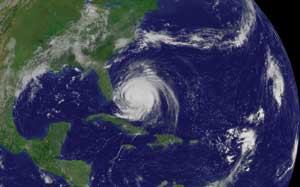Protect the Property Before a property can be closed, though, the buildings and grounds must be prepared. Hurricane-force winds (which register 74 miles per hour and up) can turn just about anything not tied down into an airborne hazard. Lounge furniture should be tossed into the pool, flags and banners should be taken down, garbage cans should be stored, and outdoor furniture, flowerpots, and any other freestanding items should be removed from balconies and patios. “It’s hard in apartments and condos because you’re so reliant on your neighbors,” says Scott Schiff, a professor of civil engineering at Clemson University in South Carolina.
But wind isn’t the only worry for those in a storm’s path: Water can be just as threatening. Because of flooding concerns, computers should be removed from the floor and placed on higher surfaces. Important records such as leasing files or other documents stored in low drawers should also be moved to higher spots.
The property itself must also be protected. While newer Florida buildings boast impact-resistant glass and shutter systems, thanks to Hurricane Andrew-influenced building codes, older structures must rely on plywood sheets to protect their windows and doors. (Schiff also suggests covering balconies with netting to prevent debris from hitting windows and breaking the glass.) Multifamily buildings “tend to do well structurally in a hurricane, but many have problems with the building envelope,” says Schiff. “It’s the windows and doors that fail.”
That’s especially a problem with the sliding glass doors often used in apartment structures. High winds can exert enough pressure to simply pop the door out from the track, exposing the apartment to rain and water damage. Deeper tracks for those sliding doors can help. How deep? “As a colleague of mine says, ‘If you don’t trip across the track walking in the door, it’s not a high-wind track,'” says Schiff.
The other big hot spot? Roofs, which can be ripped off by the force of a hurricane. These winds can also eventually pressurize the building, which increases the chance of a roof failure. “It’s the connections, the connections, the connections,” stresses David Prevatt, director of Clemson’s wind load test facility, who says multifamily builders in high-wind areas must ensure that the roof, sheathing, trusses, walls, and floors are all securely attached during construction.
(Decorative elements can also suffer. Prevatt, who traveled to Florida after Charley and Frances, saw coastal buildings that had lost roof-level parapets in the high winds.)
A compromised roof creates a host of other problems for property owners and managers. “The problem with hurricanes is that they come and do damage, and then they bring rain,” says Dave Garden, director of corporate programs at Disaster Kleenup International, a Chicago-based network of property restoration firms. “If you don’t clean it up [and dry the interiors out], you start getting into a mold problem.”
That’s a potential worry for properties that survived first Charley, and then Frances. “Charley caused wind damage. There was more destruction,” says Garden, who went to Florida to assess the damage. “With Frances, we saw a lot more water damage, because Frances hung out so long.”
It makes for a costly catastrophe. “We don’t lose that many lives in a hurricane,” Schiff says, “but we end up with billions of dollars in property damage.” He’s not exaggerating. While no estimates were available for Frances at press time, Charley’s bill had already climbed to roughly $7 billion in damage, according to news and insurance reports.
